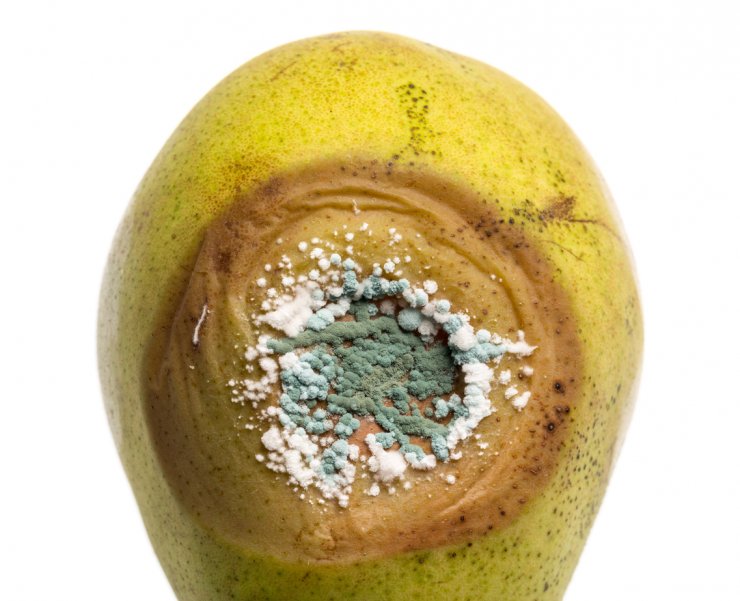
Blue mold infection on a harvested pear.
Some fungal infections attack your pears after you’ve harvested them.
Blue Mold (aka soft rot or Penicillium rot) can take hold of your harvest as you’re picking your pears, or during cold storage. Light brown, watery spots appear where the fruit has been injured. When humidity is really high, you may see grayish-blue masses of spores on the surface of the skin.
Blue mold spores are pretty much everywhere, and they can survive in all sorts of environments. You’re most likely to find this fungus in crates, boxes, and storage areas. Your best defense is to sanitize your harvesting and storage containers with fungicide or steam, and get your European pears into cold storage as quickly as possible. Be gentle as you pick and pack your pears so you don’t open them up to the risk of becoming infected.
Gray Mold (aka nest rot or cluster rot) is even worse than Blue Mold when it comes to pears. One infected pear can infect another, which infects another—until your whole crop is infected. This is a post-harvest infection that can quickly take hold while your pears are in cold storage. Wounds on the fruit are the main point of entry for this fungus; infection can also take hold at the stem or calyx (bottom) of the fruit. The mold lesions show up as tan areas without clearly defined edges; they darken or appear water-soaked as the infection progresses.
Gray mold is persistent. Keeping your collection and storage bins sanitized is your best protection against this fungus.
Mucor Rot develops at the calyx (bottom) end of the fruit or at the site of wounds to the fruit. Infected fruit can completely decay after about two months in storage. The fruits become very “juicy;” inside the juice are more fungal spores ready for spreading.
Spores of this fungus persist in the soil; the spores are also dispersed by lawn care (mowing, raking) and fallen fruit that’s been infected. This particular fungus does best in cool, dry soils. You can manage mucor rot by:
- removing and destroying any infected fruit (don’t compost it)
- separating fallen/infected fruit from healthy harvested fruit
- harvesting your pears in dry weather
- rinsing pears with water to wash off any spores, then drying them before you put them into cold storage
- keeping soil and debris off your storage bins.
Have your pear trees faced post-crop infections? How have you handled these conditions? Please share your experiences with everyone in the comments below.


 Previous
Previous

